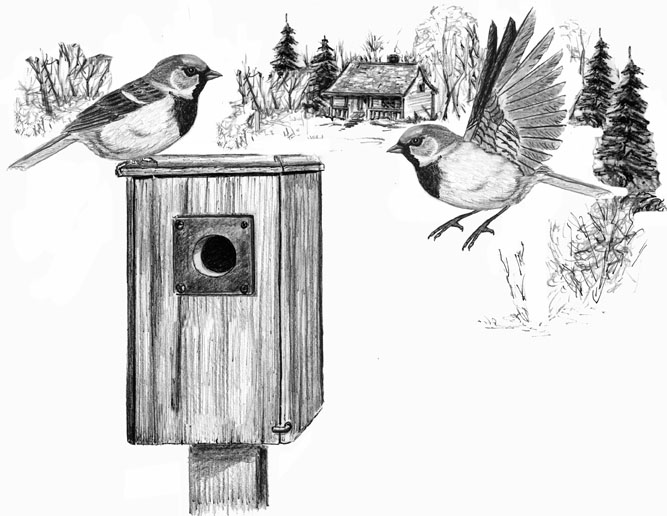
Dear Bird Folks,
I’m reading a book that claims the House Sparrow isn’t a sparrow at all; it is, in fact, an African weaverbird. But conflicting Web sites state that the House Sparrow actually is a sparrow. Bottom line, can I correctly tell my friends that I’ve seen African weaverbirds or are they just regular sparrows?
– Charley, Eastham, MA
Sorry, Charley,
Remember that catchphrase? Who started it anyhow? Oh, right. It was Starkist and their mascot, Charlie the Tuna, which I believe was a fish dressed up in a hat and sunglasses. What is it with tuna companies and their misleading logos? Chicken of the Sea has a mermaid on their label, and they aren’t selling canned chickens or canned mermaids. Then there’s Bumble Bee. What genius thought canned tuna should have a bee on the label? Probably the same guy who suggested they put honey in a bottle shaped like a bear, instead of a bee. (I guess the bee was too busy selling tuna.) While putting a bee on a can of tuna might be a little deceptive, it’s not as deceptive as telling folks you are seeing “African weaverbirds” because House Sparrows are honest-to-goodness sparrows. Sorry, Charley.
In the old days, back when I first started learning about birds, I read (probably in the same book you are reading now) that the birds we call “House Sparrows” are really weaver finches. Then one day, without checking with you or me, the bird bosses changed their minds and decided House Sparrows are actually sparrows and not weaver finches after all. To make things even more confusing, they also said House Sparrows weren’t related to our native sparrows (Song Sparrows, White-throated Sparrows, etc.). House Sparrows are considered to be Old World sparrows; conversely, our native sparrows are referred to as New World sparrows. (The bird bosses are far less creative with their names than the tuna people.) Superficially, Old World sparrows look like our sparrows (i.e., small and brown) but the Old World birds tend to have stockier bodies and shorter legs (probably so they can drive the tiny cars they have over there).
Here in the U.S. we have two species of Old World Sparrows: the aforementioned House Sparrows, and the lesser-known Eurasian Tree Sparrow. Both were brought to America in the 1800s from Europe, but while the House Sparrows spread throughout the country faster than fake stories on Facebook, the tree sparrows never moved far from their original release point, St. Louis. Apparently, the birds enjoyed the local culinary cuisine (toasted ravioli, gooey butter cakes and cans of Bud Light) and didn’t want to leave.
Today, the ubiquitous House Sparrows are one of the most abundant birds in the country…and one of the least liked. Why are they so disliked? As their name suggests, House Sparrows prefer to breed in and around buildings. Their nests tend to be a sloppy mass of dead grass, old feathers, paper and other trash, and for some reason folks don’t like that stuff around their homes. In addition, House Sparrows are super aggressive and will usurp and even kill any bird that challenges them for a nesting cavity. Many native birds, in particular bluebirds, have lost birdhouse battles to House Sparrows. This does not sit well with Americans. No bird, even the beloved cardinal, garners more emotional sympathy than the demur bluebird. Tell someone you are roasting a turkey and they’ll think “yum,” but if you tell them you saw a House Sparrow kill a bluebird, they’ll call 911.
The other problem with House Sparrows is that they travel in big flocks and no one likes flocks of anything. Whether it’s geese, pigeons or travelers on a bus tour, flocks can be annoying. My customers regularly complain when hungry House Sparrows eat all of their birdseed. Then they expect me to be supportive. But if they are looking for someone to be sympathetic about birds eating too much birdseed, they are talking to the wrong guy.
For anyone who happens to be a House Sparrow hater, or just wishes they would go away, your wish may be coming true. Over the past few decades the population of North American House Sparrows has been on a steady decline. Ironically, House Sparrows, which many folks still call “English Sparrows,” are disappearing even faster in, of all places, England. According to the BTO (British Trust of Ornithology, not Bachman-Turner Overdrive), the population of House Sparrows has dropped over 70% and they aren’t sure why. Right now, some folks might be thinking, “Who cares why. Any bird that kills bluebirds can’t disappear fast enough.” That’s an understandable attitude, but we should all keep this in mind: House Sparrows are one of the heartiest and most adaptable birds in the world. Even rats admire them. Thus, if the environment is getting so bad that House Sparrows can’t adapt, it’s not good news for any of our birds, including bluebirds.
As usual, Charley, I got a bit off-topic, but the point is House Sparrows are no longer considered to be weaver finches. Therefore, unless you take a trip to Africa (or have a time machine), you can’t correctly tell your friends you’ve seen African Weaverbirds. However, you can tell them you ate tuna out of a can with a bee on the label or honey from a bear-shaped bottle and see if they can make sense of that. I know I sure can’t.